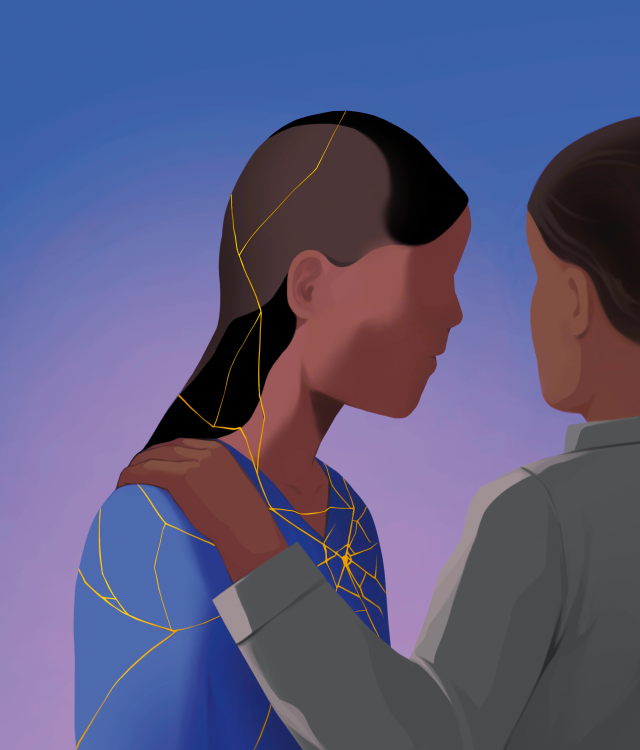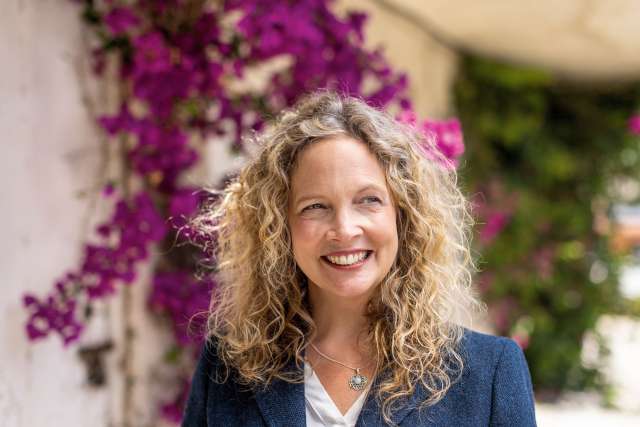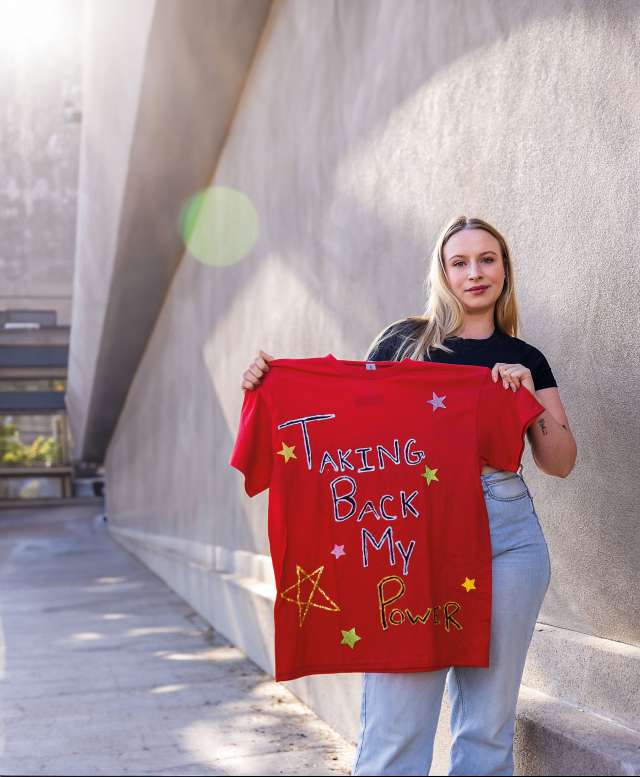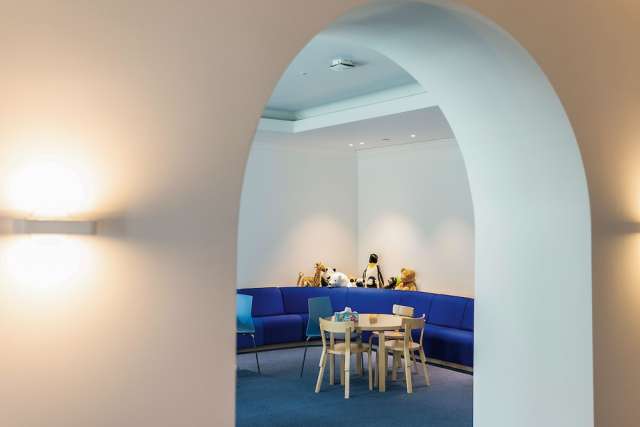
UCLA Rape Treatment Center offers healing to sexual assault victims
Julie Fordyce didn’t know anyone in Los Angeles when she moved from Arizona in the fall of 2022 to pursue her acting career. But after just a few days, she landed a job as a background player, and then found steady work in TV and movies. And, like many young actors chasing their dreams in Hollywood, she waitressed at a restaurant.
“I feel at home and happy here,” says the 23-year-old Fordyce. “It’s not just the weather; it’s being able to be more of myself here and no one’s really judging you.”
In August 2023, nearly a year after she arrived in L.A., Fordyce opened the restaurant on a Sunday morning and worked a full shift. After having dinner with friends, they went to a bar, where she saw a man she recognized from the restaurant. They’d never talked, and she did not know his name, but, uninvited, he joined her group and then followed them to a second bar. Later, when they decided to leave, her friends headed toward the back exit and Fordyce went into the bathroom. She did not notice the man trailing her.
It is there that she says he raped her.

“I was crying and kept saying to my friends, ‘I just need my mom,’” Fordyce recalls. “But I also said I need to go to the hospital. I need someone to help me. I need someone to take care of me.”
Years before, one of the friends with Fordyce had also been raped, and she knew where to go. She took Fordyce to UCLA Santa Monica Medical Center, where they were met at the entrance by a counselor. Soon, they stepped into the clinic of the Rape Treatment Center at UCLA Santa Monica Medical Center. Seeing the sign, the full reality of what had happened to her hit, and Fordyce broke down in tears again.
The Rape Treatment Center (RTC) is a world-renowned facility and a model for the comprehensive care of adult and child victims of sexual violence. Its emergency medical care and forensic services are offered 24/7, with follow-up therapy and a growing training and prevention program.
“Everybody needs justice,” says Jane Halladay Goldman, PhD, director of the RTC. “Our support for victims of sexual assault in their pursuit of justice is a commitment to standing against silence, providing the best care and evidence collection available, fostering healing and ensuring that every victim’s voice is heard and respected.

Founded by a hospital social worker 50 years ago, in 1974 (see “Breaking the Silence”) the RTC has expanded its 24-hour services to include a child-advocacy center, Stuart House, which opened in 1988 and is dedicated to child victims of sexual abuse. Today, the center sees an average of three-to-four cases every day, and its nurse practitioners and master’s- and doctoral-level therapists spend an average of four hours focused on the care of each patient.
“This level of care, unmatched in the country, is available to all, 24 hours a day, seven days a week, at absolutely no cost,” Dr. Halladay Goldman notes.
The national statistics are sobering. Every 68 seconds, an American is sexually assaulted, with the highest risk for those ages 12-to-34, according to the Rape, Abuse & Incest National Network. The majority of assaults are committed by someone known to the victim, a fact that continues to astound Sally Wilson, a nurse practitioner and the clinic coordinator, even after more than two decades working at the RTC.
“When I first started in this job, I had this conception that rape happened when you get attacked by a stranger,” she says. “But 80% of people are assaulted by someone they know. That still resonates with me to this day.”
Females comprise 90% of rape victims. But it is a crime that can happen to anyone. “We’ve seen victims from 3 months to 93 years old, females and males and people who are transgender,” Dr. Halladay Goldman says. “It’s universal.”
Fordyce curled into her chair in the clinic’s small and cozy waiting room. Her face was puffy and red from crying. The manager from the restaurant where Fordyce worked sat next to her for moral support.
A nurse practitioner and a counselor explained the protocol: There would be a detailed interview by the nurse practitioner and a police report taken by the responding law-enforcement officer; a medical forensic examination would be conducted; preventive medications would be offered, followed by counseling. Every step was her choice. She could refuse any service at any point.
Fordyce felt broken and lost as she thought about what to do, but her fight-or-flight response was tipped toward fight and urging her to do something. She said she wanted to go forward.
After she finished giving information necessary to begin an investigation, the counselor who accompanied her throughout the experience led Fordyce to an adjoining examination room. As she undressed for the medical forensic examination, Fordyce began “shaking like a chihuahua.”
“They always asked for consent and always made sure I was alright,” Fordyce says.
When the exam was over, the nurse gave her a new T-shirt and sweatpants — all of Fordyce’s clothes were kept as evidence — and medications to prevent pregnancy and sexually transmitted infections (STIs). The nurse asked her to return in two weeks for a follow-up visit.
It was daybreak when Fordyce got back to her apartment. She had been awake for 24 hours but still was unable to sleep. She took a long, hot shower, and was finally able to reach her parents by phone. Her mother immediately began the six-hour drive from Arizona to Los Angeles.
But even in her home, Fordyce remained uneasy. She wondered what would happen if she saw the man again. She no longer felt safe in the city she had come to love.
"I had this conception that rape happened when you get attacked by a stranger. But 80% of people are assaulted by someone they know."
– Sally Wilson, RTC clinic coordinator
Of all violent crimes, rape is among the most challenging to prosecute. Its difficulties begin with underreporting. Only about a tenth of victims come forward, says Beth Cranston, the RTC’s legal counsel and a former senior director. The legal process can be fraught with uncertainty due to the high evidentiary bar that must be cleared, which makes rape “one of the hardest crimes to prove.”
As in Fordyce’s case, victims often sustain no obvious physical injuries, “so you don’t always have a lot of evidence of that type,” Cranston says. “It’s also a crime that is highly recidivist — people who rape tend to rape multiple times. If you don’t arrest and prosecute people, then they have the opportunity to reoffend.”
Cranston oversees forensic services in the RTC clinic, ensuring that evidence collection, including DNA and photo and video documentation, is thorough and meets the exacting standards of the criminal justice system. “A victim’s body is a crime scene,” she says.
“Time is not our friend,” Cranston adds. Almost immediately following a rape, the window for evidence collection begins to close. But advances in DNA technology have helped to keep it open longer, expanding the timeframe from 72 to the current 120 hours. This five-day window is crucial for a medical forensic examination, as well as for most preventive medications. (Post-exposure HIV prevention is only effective within 72 hours.)
“I wish the Rape Treatment Center didn’t have to exist,” says Lesley Perkins, a Los Angeles Police Department detective with the West Bureau’s special-assault section. “But it unfortunately is a necessity, and it provides quality care to victims.”
DNA evidence collected during the medical forensic exam is essential to presenting a case to the district attorney’s office for prosecution, but the trust that nurses and counselors build with victims often provides additional information that can be critical for her investigations.
“Victims sometimes will tell clinic staff something more than they’ve told the investigating officer,” Det. Perkins says. “I know of several cases where that has made a huge difference in the investigation.”
Sometimes, however, a victim is not ready to pursue legal action. In that case, the RTC maintains two off-site freezers for evidence storage. That, Dr. Halladay Goldman says, is unique to the RTC.
“I don’t know of any other place in California that does that. Sometimes a victim might come in and think, ‘I’m not ready to report. I just want help preventing STIs.’ And we will absolutely do that. But we can also give them the option of having evidence collected and storing it. We won’t give it to the police until they decide to release it. And they can make that decision later, rather than immediately following such a traumatic event.
"Often, they go to therapy for a few weeks, or a few months, and begin to process their trauma, and very often they’ll later release it and move forward with the police.”

As it has over the past 50 years, the RTC continues to learn — and evolve — from the people it serves. “One of the values that has really stuck with me is that everything we do comes from our victims. Every program that has been developed has come out of the experiences of the people who we are trying to serve,” Dr. Halladay Goldman says.
“Now, we are seeing an increase in people who are experiencing homelessness and/or serious mental illness. So, I’m thinking about how we can help them in a more comprehensive way, so that they can eventually process their sexual trauma,” she says.
“We have great expertise within UCLA, and I’d like to pull together a think tank of experts to examine our model and see if, in collaboration with our community and UCLA partners, we can better help people get connected to resources that lead toward healing and recovery.”
And, far too often, there are those victims who are the most vulnerable: An 8-month-old girl. A deaf and mute woman with cerebral palsy. An 84-year-old woman with dementia in a nursing home. “There are victims who can’t tell their stories in court,” says Gail Abarbanel, LCSW, the RTC’s founding director. “The only thing that speaks for them and tells the story of what was done to them is the evidence we collect in the clinic.”
After Dr. Halladay Goldman graduated in 1996 from Middlebury College in Vermont with a BA in psychology and women’s studies, she moved to Los Angeles, where she worked at several jobs before becoming a receptionist at Stuart House.
“I thought, ‘Well, until I figure out what my next step is, this seems like a really great place to explore a lot of different career options,’” she says. But she soon fell in love with the place, and the work, and went on to become the office manager at Stuart House. Over the years, she completed her master’s and doctorate in social welfare at UCLA. For her dissertation, she studied feminist organizations with values similar to the RTC’s.

As she continued working at the center, as a child advocate at Stuart House and an on-call counselor for the RTC, she noted that many victims were not coming to follow-up appointments. She researched why and found that people with PTSD have a 50% no-show rate.
“The kids were almost always coming back because their parents were putting them in the car and bringing them here,” Dr. Halladay Goldman says. “But for adults, when they imagine coming back into the room that they had been in immediately following their assault, it still feels very connected to the event.”
To help address that issue, a follow-up clinic for ongoing therapy was established, in a light-filled, brightly colored building across the street. That, in combination with improved communication strategies, helped boost the rate of in-person follow-up visits to 60%.
That is where Fordyce went two weeks after she was raped. Her drive and ambition were prodding her to “just get back to normal,” she says, but it was hard to resume her acting work. Reading and taking care of her pet corgi helped her to maintain a routine. But Fordyce was uneasy and hypervigilant outside her home, especially with men. Weekly sessions with her therapist helped her to address that.
“We talked about goals,” Fordyce says, “and my goal was feeling safe in the city again.”
In later sessions, she created a personal slogan: “Taking Back My Power.” She painted the phrase onto a bright red T-shirt, surrounded by glittering stars, during an arts-and-crafts therapy session.

Paige Adams-Geller, too, found her power at the RTC. When she was 29 years old, Adams-Geller was sexually assaulted in her workplace, a clothing company where she was a model. As she hurried out of the building after the assault, she felt herself “having a meltdown” and experiencing severe PTSD. She called the RTC and scheduled a counseling appointment. But she had never gone to therapy before and was petrified.
She kept the appointment, and “I immediately felt very safe. My therapist’s warmth and compassion made me feel like I was talking to a friend,” Adams-Geller says. “From the moment I walked in the door, I wasn’t judged. I was nurtured.”
Further sessions helped her uncover why she experienced PTSD immediately after the assault: She had been raped by a family friend at the age of 16 and never told anyone.
“I spent 13 years fighting anorexia because physically and mentally I wanted to disappear,” Adams-Geller wrote in an essay published in 2018 in British Vogue. She, like many other victims, blamed herself for being attacked. “I felt empty inside, never good enough. I suffered horrible, recurring nightmares that I was buried alive and couldn’t get out of the grave. I had no voice. No one could hear me, and I couldn’t move my arms or legs — just like the night I was raped.”
Six months of therapy at the RTC gave her the courage to enter an intensive 30-day residential center to heal from the trauma and self-sabotaging behaviors. “This was the next event that changed my life forever,” she wrote in her essay. “The silence lifted. Once my secrets were revealed in a safe place, I let go of all the shame. I didn’t ask to be a victim of rape and sexual assault. No one does.”
It also gave her the courage to file a civil lawsuit against the man who assaulted her. She then created her own company and clothing brand, PAIGE, with a special focus on creating a safe work environment.
And Adams-Geller stayed connected with the RTC, attending its annual brunch, where she heard other survivors speak about their experiences. Slowly, she felt strong enough to be more open about her own rape and sexual assault.
Twelve years ago, she joined the RTC’s board of directors, and on July 1, 2024 — 20 years to the day after creating her company — she became chair of the RTC board. It is a role in which she hopes she will be able to help other survivors.
“There are more people than you realize who share your experience,” Adams-Geller says. “I don’t want someone to go through as much pain as I went through for 13 years. You can get on that healing journey faster if you seek help.”

Det. Perkins has investigated hundreds of sexual assaults during her 17 years with the LAPD. As she considers all the cases she has handled over the years, one in particular in which the RTC played a crucial role in winning a conviction comes to mind. In Fall 2021, a UCLA student living off-campus awoke at 4 in the morning to a bright light shining in her face and a man standing over her bed, sexually assaulting her. She screamed, and he fled.
Det. Perkins responded to the student’s apartment, where the victim told her that several weeks before, her roommate had woken in the middle of the night and seen a man in their apartment. Surveillance video from the apartment building captured images of the man and his vehicle, and Det. Perkins had a hunch that he would return. She requested extra patrols in the area, and two weeks later, an officer with the UCLA Police Department spotted the man and cited him for a traffic violation.
After putting the suspect under surveillance, Det. Perkins and her team arrested him three days later. On his three phones, they found videos of the 10 times he had visited the women’s apartment. But the phones revealed even more about the suspect, who was a driver for a rideshare service. “There were multiple videos of him sexually assaulting vulnerable women who are unconscious in the back of his car,” she recalls. “It was awful.”
It took a month of further investigation to determine the identities of the victims — a month during which Det. Perkins says she barely slept. “Now I have to tell these women who have no idea they have been sexually assaulted what we’ve learned,” she says. “How am I going to do that?”
Her supervisor recommended that Det. Perkins bring a counselor from the RTC when she went to speak with each of the 15 victims. “That was the key,” Det. Perkins says. “As soon as I broke the news, the counselor was there for them to talk to,” and each of the women ultimately would testify at his trial.
Last November, Javier Gomez Herrera, 42, was convicted of multiple assaults and burglaries and sentenced to up to life in prison.
“The involvement in this case of the counselors from the RTC was invaluable,” Det. Perkins says. “Coming with us when we spoke with the women, providing them with support and resources — the victims recognized they had a strong team behind them to help them through the long and arduous court process to obtain justice.”
Training is essential to the mission of the RTC and Stuart House, and the RTC has worked to expand its education program — based on the pillars of awareness, education and empathy — to a wider audience. It has, for decades, conducted specialized training for law enforcement, and now it is reaching out to parents, schools and colleges as well.
On a recent weekday evening, Marisa Faynsod, LCSW, the RTC’s community and campus outreach coordinator, hosted a Zoom webinar for volunteers at UCLA UniCamp. The attendees were UCLA students who would be counselors at the summer program for youths ages 10-to-17. In an interactive, hour-long session, Faynsod talked to the future counselors about child sexual abuse and described the services offered at the RTC and Stuart House.

She also stressed the importance of bystanders as the most effective deterrent to sexual violence. Bystander training is incorporated into all RTC high school and college trainings, as well as a recent partnership between the RTC and the City of West Hollywood to train bartenders and servers who work in the city. (The city passed an ordinance in 2021 requiring such training at businesses that serve alcohol.)
“These are people who are in a position to notice when a dangerous situation might be developing,” Faynsod says. “But we emphasize that it doesn’t have to be putting on a cape and being the hero. It can be as simple as making eye contact or asking, ‘Is everything OK here?’”
Last year, more than 3,000 employees underwent the RTC training.
The RTC is looking to expand the program so it can conduct more such trainings. “We’re looking to prevent sexual assault,” says Julie Banks, PhD, the RTC’s policy and program development director. “But we’re also looking to raise awareness. And we want people to know that we’re here as a support. We don’t want victims to suffer alone, which a lot of people do.”
After a half-century of helping victims during the most vulnerable period of their lives, the center has amassed a trove of valuable data that, Dr. Banks believes, is ripe for scientific study and publication. “We have a lot of information that could be very helpful to the community. There are amazing researchers here at UCLA, and we’d like to tap into some of the great research possibilities and partnerships that are available here,” she says.
That also is a priority for Dr. Halladay Goldman. “I want to be able to view all this data we’ve collected through a stronger research lens so that we can really dive into it and share the wealth of knowledge we gathered throughout the last 50 years,” she says. “This can be invaluable in helping to ensure that we are using evidence-based treatments for our clients that are best suited to their specific needs.”
But such an effort, as well as expanding prevention programs, requires significant funding. Though donors help maintain the RTC’s operations, the center’s major government grants — totaling $1 million — are in jeopardy. These grants are funded by the federal Victims of Crime Act (VOCA), which has a 45% budget shortfall. The State of California provided a temporary backfill for 2024, but future grants are not assured. The center will rely on fundraising to help fill more staff positions, especially for its prevention and training work.
"We want people to know that we’re here as a support. We don’t want victims to suffer alone, which a lot of people do."
– Julie Banks, RTC policy and program development director
No perpetrator in Fordyce’s assault has yet been charged, but the investigation continues.
“He may not serve time,” Fordyce says through tears. “But if it happens again, my case shows a repeat offense. Even though I suffer the consequences, another girl can get justice.”
In June, she completed her final therapy session. Her PTSD symptoms have markedly decreased, and her sense of safety has been restored. She is back to working full-time as an actress and at the restaurant.
“Even though some of us may feel shattered and powerless, the Rape Treatment Center is a place to heal,” Fordyce says. “I’m able to laugh and cry — to cry happy tears. I’m able to not feel numb anymore. I’m me again.”
Mary-Rose Abraham is senior science writer for UCLA Health. Before coming to UCLA Health, she was a multimedia journalist whose stories were featured on ABC News, BBC News, NPR and National Geographic, among other outlets.
Learn more about the Rape Treatment Center at UCLA Santa Monica Medical Center.